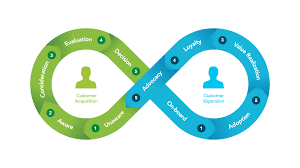How Do SaaS Companies Apply the TPG Loop?
Connect PLG and sales with one operating model—PQL/MQL SLAs, instrumented experiences, clean sourced vs. influence, and a scorecard that drives start/stop/scale decisions.
SaaS companies use the TPG Loop to connect product-led growth and sales-led motions under one governance model. Product usage and trial data create PQLs that share definitions and SLAs with MQLs. Ads, pages, in-app CTAs, emails, and sequences are associated to campaigns for clean measurement. An executive scorecard reports sourced (attribution) and influenced (associations) impact alongside velocity, win rate, adoption, expansion, and NRR, which the revenue council reviews monthly.
The SaaS Growth Engine at a Glance

Five Ways SaaS Teams Apply the Loop
From Product Signals to Revenue Decisions
The Loop begins with a metric dictionary that covers lifecycle (visitor → user → PQL/MQL → SAO/SQL → customer), acceptance rules, and recycle paths. PQL criteria combine activation events, feature adoption, and seat thresholds aligned to ICP. These leads are owned with the same SLA rigor as MQLs, and dispositions are standardized for coaching.
Instrumentation makes outcomes traceable. Campaign associations span ads, CMS pages, forms, in-app CTAs, onboarding emails, webinars, and seller sequences. Sales and success playbooks mirror the offers in product prompts, ensuring consistent proof and messaging from free-to-paid through expansion.
Measurement is board-safe. Sourced revenue uses one executive attribution model; influence is shown with contact/deal associations and an explicit overlap view that prevents double counting. Beyond pipeline and win rate, the scorecard tracks activation, adoption milestones, seat/feature expansion, renewal forecasts, and NRR. A monthly revenue council reallocates budget and owners—scaling plays that move activation, conversion, and expansion while deprecating what doesn’t.
PQL/MQL to Revenue — Signal → Owner → SLA → Action → KPI
| Signal | Primary owner | SLA | Action | KPI on scorecard |
|---|---|---|---|---|
| Activation reached (e.g., feature X + Y users) | SDR | First touch < 24h | Sequence + value path; schedule discovery | Free→Paid conversion, pipeline created |
| Trial expiration < 3 days | AE | Meeting set < 48h | Offer guided upgrade; demo success outcomes | Win rate, cycle time |
| Usage spike (seats > threshold) | CSM | Play launch < 72h | Growth plan + expansion proposal | Expansion ARR, NRR |
| High-fit MQL (web + intent data) | SDR | First touch < 24h | Tailored outreach; PQL convert path if product used | Accepted meeting rate |
| Churn risk (low adoption) | CSM | Save play < 48h | Enablement + executive sponsor call | Renewal rate, NRR |
Frequently Asked Questions
Unite PLG and Sales with One Revenue Loop
We’ll codify PQL/MQL rules, instrument in-app and campaign associations, and publish a board-safe scorecard—so growth decisions follow evidence.
Talk to a SaaS RevOps Architect